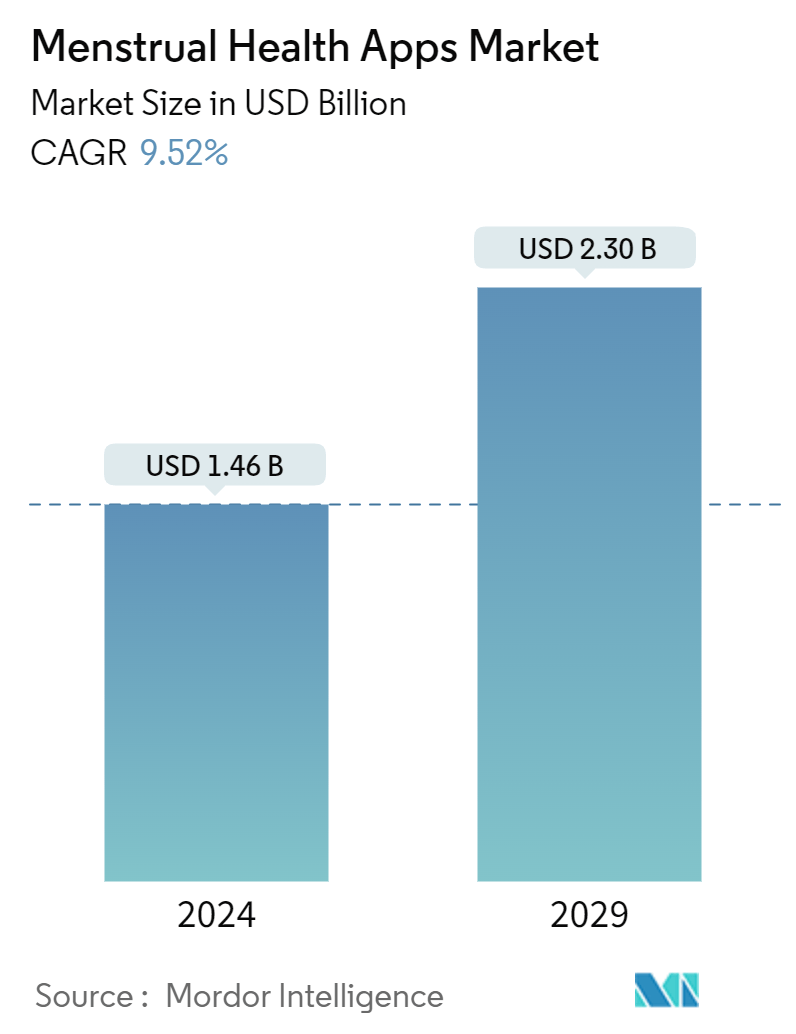Market Size of Menstrual Health Apps Industry

| Study Period | 2019 - 2029 |
| Market Size (2024) | USD 1.46 Billion |
| Market Size (2029) | USD 2.30 Billion |
| CAGR (2024 - 2029) | 9.52 % |
| Fastest Growing Market | Asia-Pacific |
| Largest Market | North America |
Major Players
*Disclaimer: Major Players sorted in no particular order |
Menstrual Health Apps Market Analysis
The Menstrual Health Apps Market size is estimated at USD 1.46 billion in 2024, and is expected to reach USD 2.30 billion by 2029, growing at a CAGR of 9.52% during the forecast period (2024-2029).
The COVID-19 pandemic had a positive impact on the market. Menstrual health apps witnessed significant spikes in the adoption rate and recorded a dramatic rise in the number of users. Female communities across the globe were using femtech applications to maintain a healthy lifestyle and well-being. For example, the NCBI published a study in 2021 that looked at the impact of COVID-19 on menstrual cycle distress and the use and adoption of mobile apps by women during the pandemic.As per the results, around 77.9% of respondents reported using menstrual health-related mobile apps during the pandemic. This signifies that digital health technologies for women gained traction during the pandemic.
In addition, established players are developing their apps in multiple languages to expand their clientele across the globe. For instance, Flo Health Inc. launched Flo, a menstrual and pregnancy tracking app, in 22 languages. The app allows users to track pregnancies and monitor fetal development and offers personalized daily informational content. Furthermore, Flo reported that around 35 million users were using its app monthly in 2020, with a total of 150 million installations.
Rising consciousness about menstrual health among women, the rise in digital literacies and smartphone adoption, increased internet accessibility, and the incidence of growing awareness of menstrual health hygiene are the factors driving the growth of the menstrual health apps market over the forecast period.
The rise in digital literacies and smartphone adoption is also propelling the growth of the market; for instance, in 2021, the International Telecommunication Union showed that uptake of the internet has accelerated during the pandemic. In 2019, 4.1 billion people (54 percent of the world's population) were using the internet. Since then, the number of users has surged by 800 million to reach 4.9 billion people in 2021 (63 percent of the population).
In addition, new menstrual app launches and strategic activities by major players in the market are positively affecting the growth of the studied market. For instance, in December 2020, the LAIQA brand launched an app called Period Pal. This app can chart their menstrual cycles, as well as their energy levels, symptoms, and ovulation cycle predictions.
Furthermore, the growing focus of companies on developing advanced services and adopting various business strategies, such as collaborations and acquisitions, to maintain their market position is also contributing to market growth. For instance, in May 2022, Fertility Company Aprecicity acquired Period Tracking and Community Support App Woom, a women's health app offering period tracking and community support for those trying to conceive. Therefore, owing to the aforementioned factors, it is anticipated that the studied market will witness growth over the analysis period.
Menstrual Health Apps Industry Segmentation
As per the scope of the report, the menstrual health application allows women to track their menstrual cycles and receive a prediction for their period dates. Most apps also provide predictions of ovulation day and the fertile window. The menstrual health apps market is segmented by application type (period cycle tracking, fertility and ovulation management, and menstrual health management), platform type (android, iOS, and other platforms), and geography (North America, Europe, Asia-Pacific, the Middle East, Africa, and South America). The report offers the value (in USD million) for the above segments.
| By Application | |
| Period Cycle Tracking | |
| Fertility & Ovulation Management | |
| Menstrual health Management |
| By Platform | |
| Android | |
| iOS | |
| Others |
| Geography | ||||||||
| ||||||||
| ||||||||
| ||||||||
| ||||||||
|
Menstrual Health Apps Market Size Summary
The menstrual health apps market is poised for substantial growth, driven by increasing awareness of menstrual health, the rise in digital literacy, and the widespread adoption of smartphones. The COVID-19 pandemic acted as a catalyst, significantly boosting the adoption rates of these apps as women sought to maintain their health and well-being through digital means. Companies are expanding their reach by developing apps in multiple languages and incorporating advanced features such as pregnancy tracking and personalized content. The market is further propelled by strategic initiatives from key players, including new app launches and acquisitions, which enhance their service offerings and market presence. The integration of innovative technologies in wearables and mobile applications also supports the efficient management of women's health, contributing to the market's expansion.
North America is expected to lead the market, supported by robust research and development activities, a strong presence of key industry players, and a growing demand for period cycle tracking apps. The region's focus on increasing awareness and education around menstrual health issues, coupled with technological advancements, is likely to drive market growth. The market is characterized by strategic initiatives such as competitive pricing, partnerships, and product expansions by leading players like Flo Health, Glow Inc., and Apple Inc. These efforts, along with supportive government policies and initiatives aimed at improving women's health awareness, are anticipated to foster significant growth in the menstrual health apps market over the forecast period.
Menstrual Health Apps Market Size - Table of Contents
-
1. MARKET DYNAMICS
-
1.1 Market Overview
-
1.2 Market Drivers
-
1.2.1 Increased Awareness of Health Issues Among Women
-
1.2.2 Rise in Digital Literacies and Smartphone Adoption
-
1.2.3 Increasing Adoption Rate of Smart Wearables Coupled with Increased Internet Accessibility
-
-
1.3 Market Restraints
-
1.3.1 Lack of Data Security
-
-
1.4 Porter's Five Forces Analysis
-
1.4.1 Threat of New Entrants
-
1.4.2 Bargaining Power of Buyers/Consumers
-
1.4.3 Bargaining Power of Suppliers
-
1.4.4 Threat of Substitute Products
-
1.4.5 Intensity of Competitive Rivalry
-
-
-
2. MARKET SEGMENTATION (Market Size by Value - USD million)
-
2.1 By Application
-
2.1.1 Period Cycle Tracking
-
2.1.2 Fertility & Ovulation Management
-
2.1.3 Menstrual health Management
-
-
2.2 By Platform
-
2.2.1 Android
-
2.2.2 iOS
-
2.2.3 Others
-
-
2.3 Geography
-
2.3.1 North America
-
2.3.1.1 United States
-
2.3.1.2 Canada
-
2.3.1.3 Mexico
-
-
2.3.2 Europe
-
2.3.2.1 Germany
-
2.3.2.2 United Kingdom
-
2.3.2.3 France
-
2.3.2.4 Italy
-
2.3.2.5 Spain
-
2.3.2.6 Rest of Europe
-
-
2.3.3 Asia-Pacific
-
2.3.3.1 China
-
2.3.3.2 Japan
-
2.3.3.3 India
-
2.3.3.4 Australia
-
2.3.3.5 South Korea
-
2.3.3.6 Rest of Asia-Pacific
-
-
2.3.4 Middle-East and Africa
-
2.3.4.1 GCC
-
2.3.4.2 South Africa
-
2.3.4.3 Rest of Middle East and Africa
-
-
2.3.5 South America
-
2.3.5.1 Brazil
-
2.3.5.2 Argentina
-
2.3.5.3 Rest of South America
-
-
-
Menstrual Health Apps Market Size FAQs
How big is the Menstrual Health Apps Market?
The Menstrual Health Apps Market size is expected to reach USD 1.46 billion in 2024 and grow at a CAGR of 9.52% to reach USD 2.30 billion by 2029.
What is the current Menstrual Health Apps Market size?
In 2024, the Menstrual Health Apps Market size is expected to reach USD 1.46 billion.

